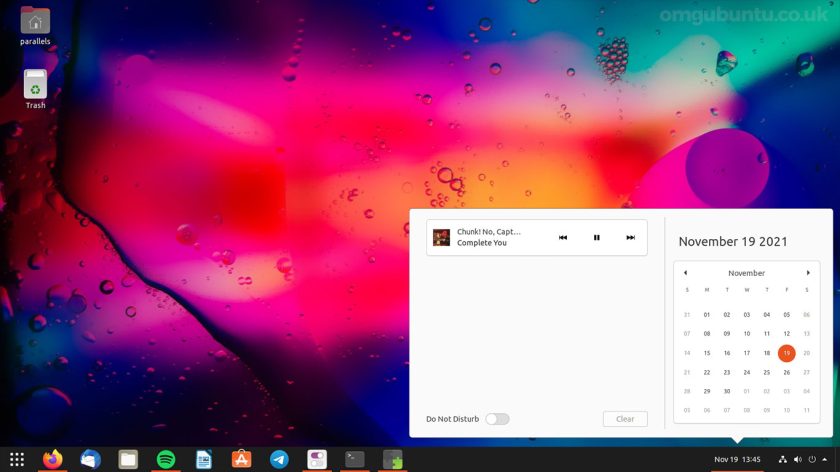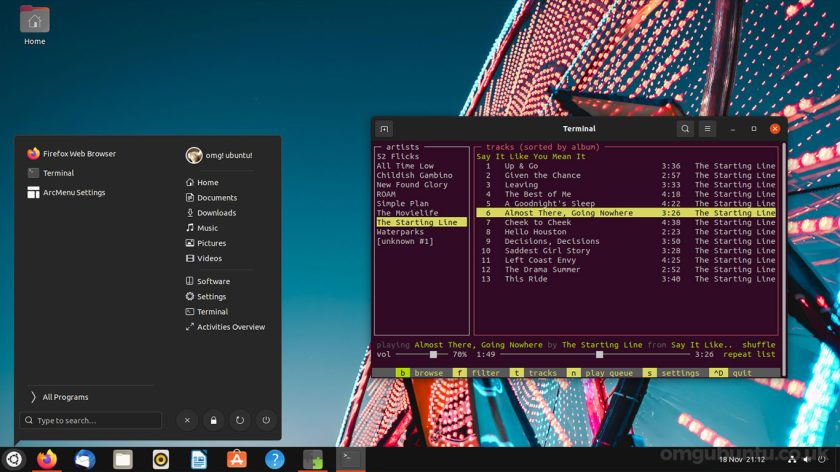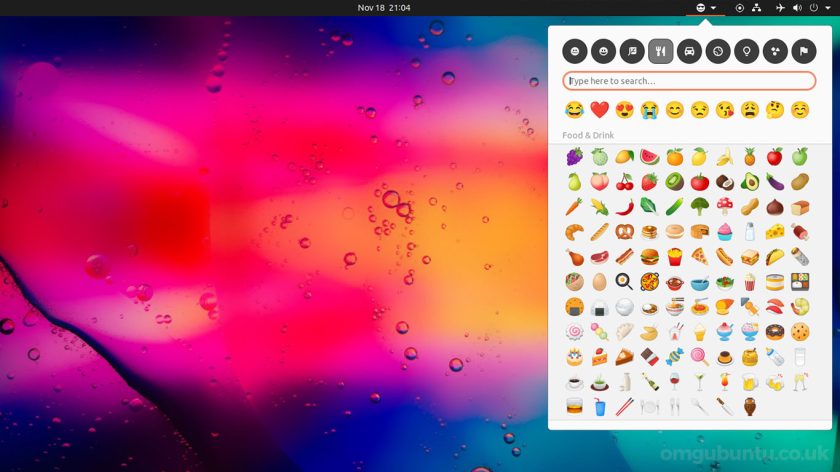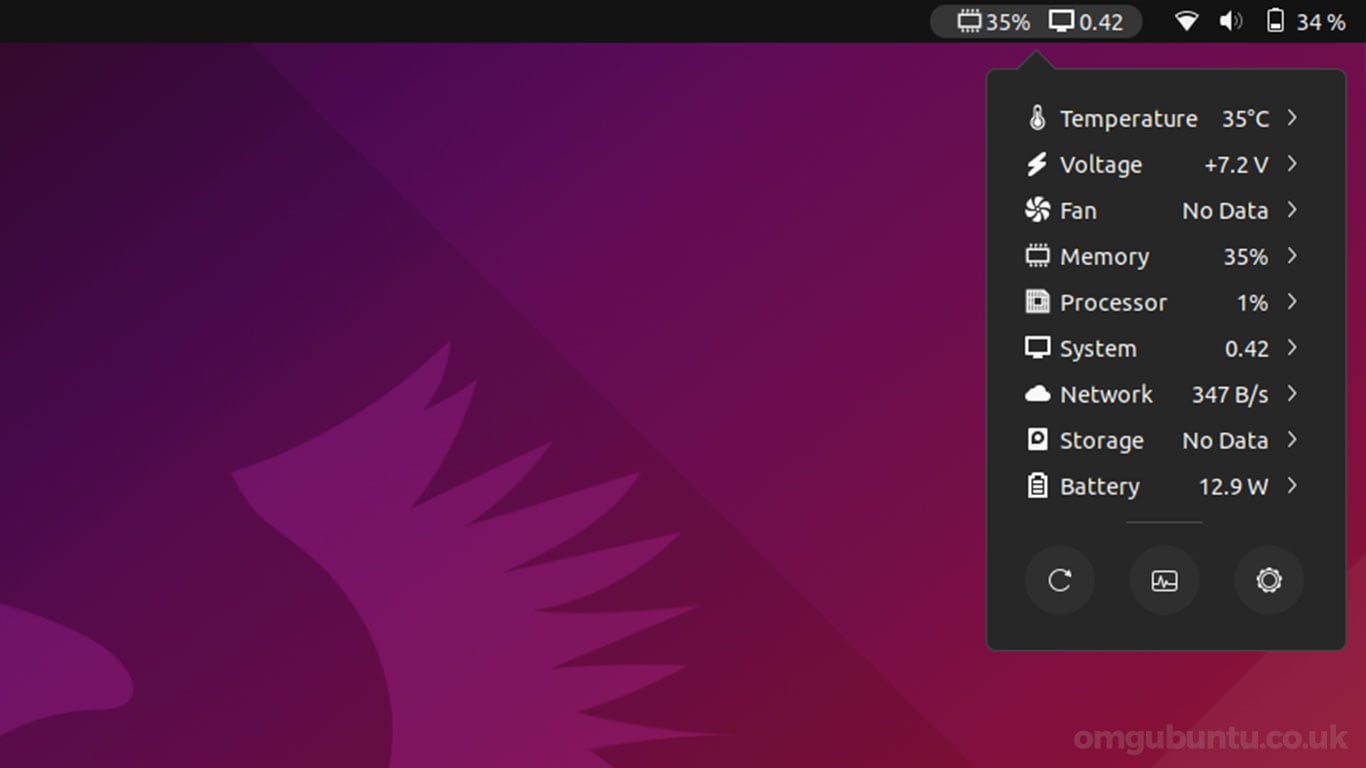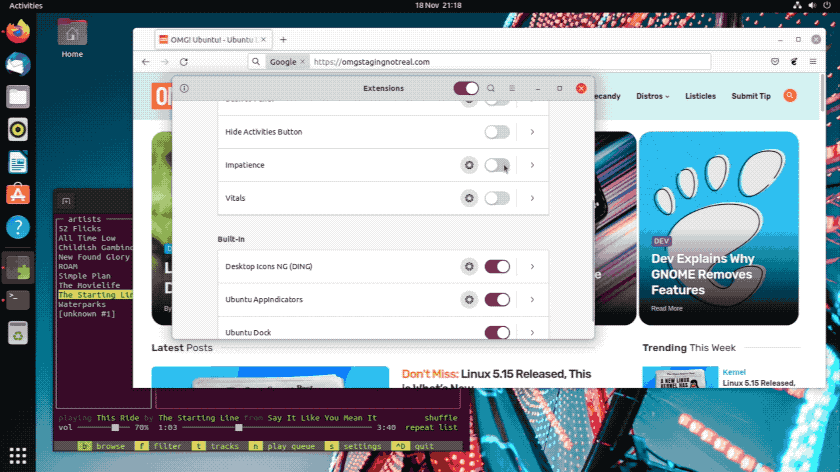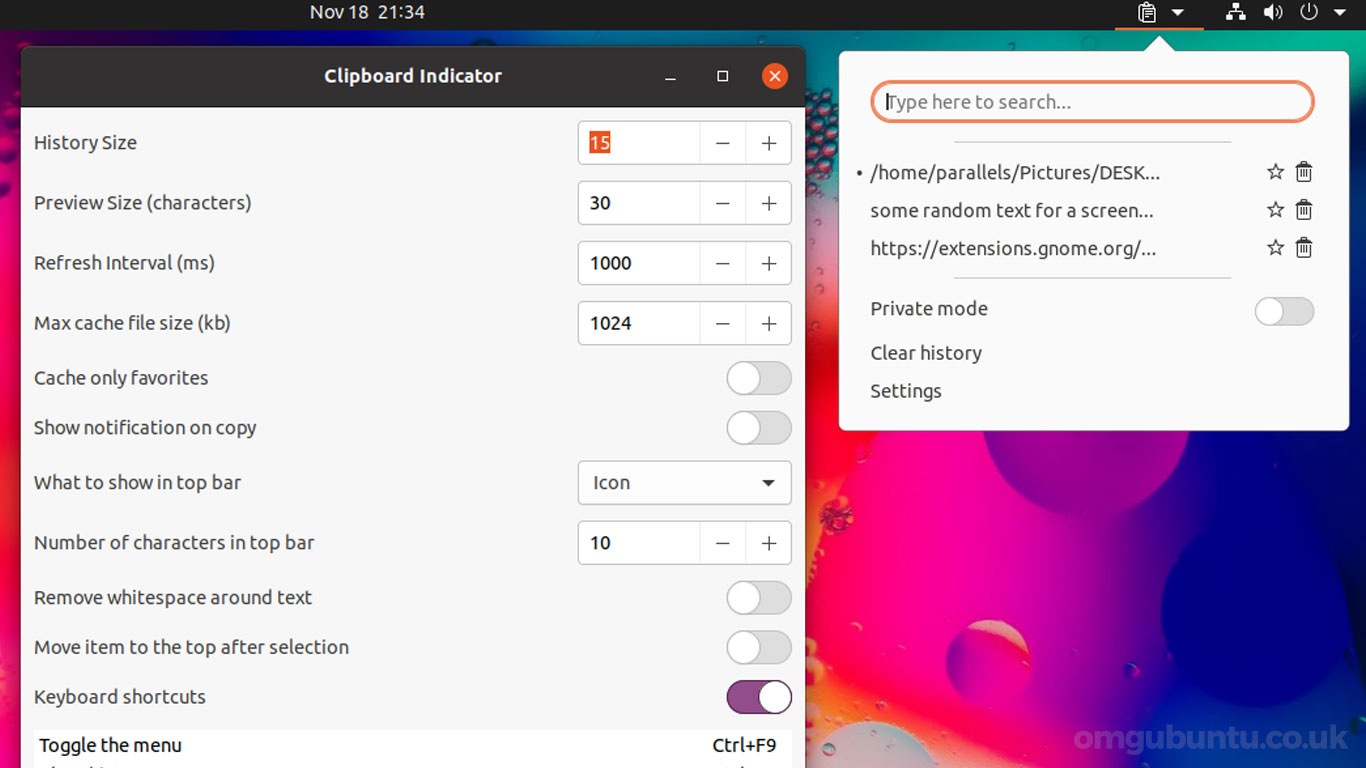Using GNOME Shell extensions you can transform your Ubuntu desktop into a personalised workspace filled with awesome new features.
You can make Ubuntu faster, easier, and prettier using GNOME Shell extensions
But with a vast of array of extensions available, where do you start?
How about here? In this curated list of the best GNOME extensions for Ubuntu you will discover add-ons that will enhance your productivity, prettify your desktop, and more.
To ensure maximum usefulness, every extension included on this list is actively maintained, and works with Ubuntu 22.04 LTS and later releases.
Ready to uncover the amazing GNOME Shell extensions that await?
Read on!
15 Best GNOME Shell Extensions
1. Dash to Panel
Dramatically change the look and feel of Ubuntu with Dash to Panel.
More than ‘just’ a horizontal dock, Dash to Panel fuses app launcher, task list, top bar, and system tray into a single, unified panel that closely resembles desktop setups found in Microsoft Windows and KDE Plasma.
A slate-load of options give you absolute control over (almost) every part of the extension, including its position on the desktop, how it looks, integrations, and animations. There are also toggles to disable fancier flourishes (which can be laggy on older machines) like window previews on hover.
For a streamlined and stylish GNOME desktop experience (that works well with a traditional app menu add-on like Arc Menu, see below) Dash to Panel is the extension to try.
2. Arc Menu
Ubuntu uses GNOME Shell, and GNOME Shell uses a full-screen app launcher by default. Although it’s nice to look at some find it a bit too “in-your-face” and replace it with Arc Menu.
Arc Menu is a ‘traditional’ app menu for GNOME Shell accessed from the desktop, much like the Start menu on Windows. But unlike Window’s start menu this thing is customisable.
Indeed, nearly every aspect of Arc Menu, from where it shows up to how fast it shows up, can be tweaked. You get 21 menu layouts to choose from (some inspired by other OSes, like Windows 11’s new launcher) and lots of configuration options to fine-tune each menu layout.
Better yet Arc Menu is updated regularly. New updates add more options, new menu layouts, and deliver performance enhancements.
3. Burn My Windows

This extension is totally superfluous, but terrifically fun at the same time. If you’ve been using Linux long enough to remember the Compiz era then the animations provided by ‘Burn My Windows’ will be familiar.
And if you’re not? You’re in for a real treat.
When you install and enable this extension you get an over-the-top window closing animation show up every window and dialog you close. The default effect is a flame effect, but several other options are available (though some do require GNOME 40 or later).
What’s particularly interesting is that all of the very OTT animations this extension provide are native shaders; they use the same technology that all of GNOME’s existing UI animations use.
4. Net Speed Simplified
Looking for an easy way to monitor network speed in Ubuntu? Look no further than the Net Speed Simplified GNOME extension. It’s not the only extension available for this task, but it’s the one I think is the best looking and easiest to use.
With a simple left-click on its panel icon, you can seamlessly toggle through 5 different display modes. Right-clicking will show or hide the download statistics. Middle-clicking cycles cycles chances the font size.
For those with greater customisation needs, the extension’s preferences panel has a ton of options, including the ability to personalise the panel applet with a specific font or colour scheme, select an icon style, adjust the refresh rate, and more.
For keeping an eye on real-time network activity in Ubuntu, this extension is a must-have.
• Get Net Speed Simplified on GNOME Extensions
5. Caffeine
Chances are you’ve either heard about Caffeine before or used it back when it was a standalone desktop app. These days it’s best distilled as a GNOME extension.
A deliciously simple utility, the Caffeine GNOME extension adds a small icon to the top bar. To stop Ubuntu’s lock screen, screensaver (if you use one), or auto-suspend from kicking in, you click it (and when you don’t need to prevent those from activating you click it again.
If you’ve ever found yourself interrupted by the lock screen while watching a video or reading a lengthy web article you’ll appreciate this utility.
6. Improved Workspace Indicator
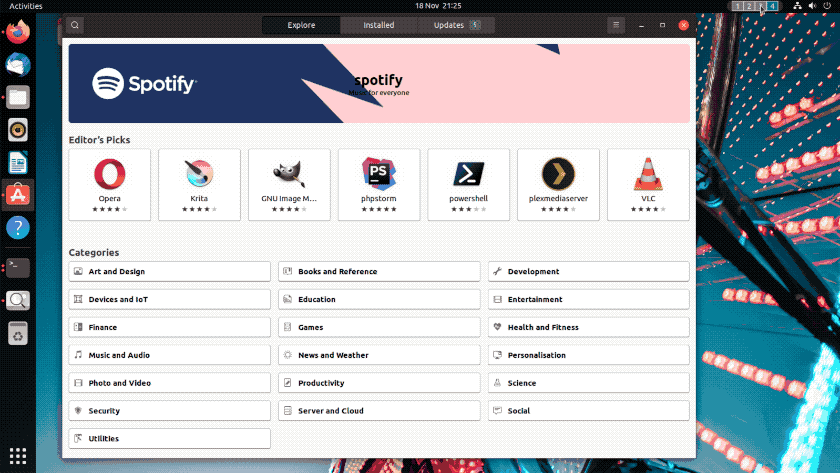
If you make heavy use of workspaces in GNOME Shell then installing the (suitably named) Improved Workspace Indicator extension is a no-brainer.
Taking cues from Sway/i3, this no-frills applet adds a workspace indicator to the top bar so that you can see which workspace you’re on without needing to enter the overview.
But the fun doesn’t end there, my friend! This “indicator” is also a workspace switcher. Click any workspace number shown in the tray icon to instantly jump to the corresponding workspace, pronto.
7. Emoji Selector
I’ve shown you how to use emoji on Ubuntu before (quick recap: press ctrl + . in the text field of a GTK app) but GNOME’s native emoji picker doesn’t work everywhere or with every app.
So for an equally fast way to sift, sort, and search through the lexicon of pictorial embellishments use the handy Emoji Selector GNOME extension.
It adds a little character to the top bar. Click the icon to open the picker from where you can browse emoji by category or search for a glyph by name (though some emoji are not called what you think). You can copy any emoji to your clipboard (ready to paste elsewhere) just by clicking on it.
Faster than a 🐢, prettier than a 🐼.
8. Desktop Icons NG
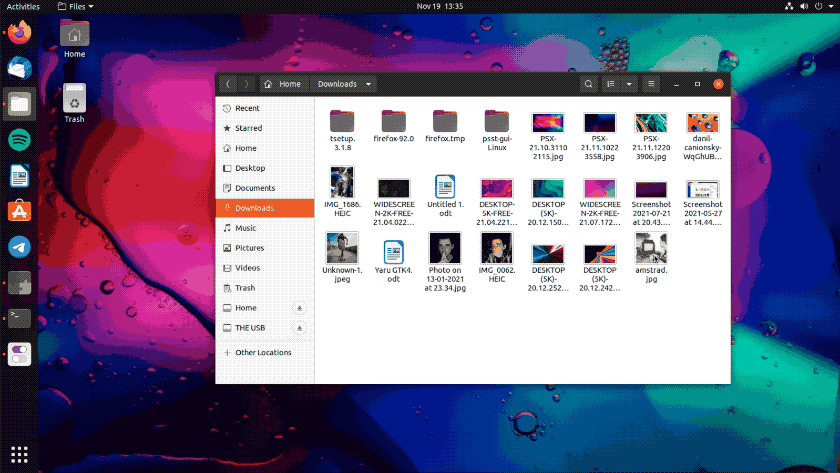
This extension is aimed squarely at those of you using Ubuntu 20.04 LTS — and you’re going to want it as it fixes the single biggest drawback of that otherwise solid release: the inability to drag and drop files from the file manager on to the desktop.
Upstream GNOME developers retired Nautilus’ support for managing the “desktop” space a few years back, leaving the role to third-party extensions. While recent version of Ubuntu come with an enhanced desktop icons extension already installed the incumbent LTS releases do not.
So if you use Ubuntu 20.04 LTS and actively use your desktop as an active workspace — high five ‘cos I do too — you need to switch to Desktop Icons NG. If you run Ubuntu 21.04 or 21.10 you don’t need to do anything as you already have this awesome add-on installed (and it’s activated by default).
9. WinTile
GNOME Shell doesn’t natively support quarter tiling so to snap windows to corners in Ubuntu like you can on Windows 10 you’ll need to use a third-party extension.
WinTile is the one I use, and I’ve no complaints with it. Once WinTile is enabled you have two ways to arrange apps: drag windows to the corners of your screen to ‘snap’ them quarter tile style; or use the super and arrow keys on your keyboard to instantly tile the focused app in a variety of layouts.
You can also adjust the number of columns, enable support for window minimising, and fine-tune the behaviour of window previews (the ghost effect you see in the screenshot above) from the extension’s settings section.
If you work with a lot of windows and want some features of a tiling window manage, check this extension out.
10. BlurMyShell
Most of the items on list are focused on providing utility and practicality — so here’s something completely opposite: an extension that’s unapologetically all about the aesthetics.
Whether you use Ubuntu 20.04 LTS or the latest Ubuntu 21.10 release with GNOME 40, the Blur My Shell extension gives you precisely what it says it will: a frosted blur effect throughout the GNOME Shell UI. This includes the app launcher, activities overview, search screen, and (where possible) other GNOME Shell extensions too.
Is it useful? Eh, you could possibly make an argument that blurring out the background of UI elements makes text on top more visible. But let’s be honest: no-one is installing this for that. This is pure, unashamed bling.
But if you’ve got a good enough computer, why not? You’re entitled to look at nice things too!
11. Hide Activities Button
This GNOME extension for Ubuntu and other GNOME-based distros doesn’t need much of an explanation as it does what exactly says on the tin: hides the ‘activities’ label from the top bar.
If you don’t tend to enter GNOME Shell’s Activities overview using this button, and find the omnipresent option for it a touch grating as a result, install this to make it vanish, pronto!
12. Vitals
You didn’t think I could compile a list of epic GNOME extensions and not mention at least one system monitoring tool, did you? Vitals is, well, pretty vital for those who like to keep an eye fixed on their system’s resources.
While it is easier to monitor and manage system resources using cool command line tools like btop++ Vitals is great for passive monitoring. Glanceable. Quick look. That kinda use case.
It can be configured to show the stats you care about, including CPU temperature, fan speed, memory usage, processor load, network speed, battery info, and storage stats. The add-on uses asynchronous polling (configurable, naturally) for speedy, but stable use.
For a less serious take on CPU monitoring, check out the humorous RunCat extension too!
13. Impatience
You can speed up GNOME Shell’s animations for a faster, more responsive feeling experience using the wryly named Impatience GNOME extension.
By default, Impatience speeds up animations for entering the Activities overview, opening the app launcher, navigating workspaces, etc twice as fast. If that’s not enough you can speed them up further by adjusting the slider in the extensions settings (where you can, conversely, slow animations down too).
This power-up works great alongside other add-ons in this list, like the Improved Workspace Indicator extension.
14. Clipboard Indicator
If you regularly copy/paste the same snippets of text to and from different apps you might be considering using a dedicated clipboard manager app for Ubuntu — but give the Clipboard Indicator GNOME extension a ry first.
This handy applet does puts a small clipboard icon in the tray area and, thereout, keeps a history of clipboard contents that you can quick re-copy at a later date. You can specify the memory cache size (i.e. last 10 items, or last 100 items) and quickly toggle a private mode on/off as you need.
If your clipboard needs are pretty basic (like mine are) you’ll find this add-on proves itself handy in no time. While it can’t remember all types of content you copy it does remember the most essential: text, links, and emoji. Give it a try — you might wonder how you managed with out it!
15. Custom Hot Corners – Extended

If you’re a mouse-centric user then enabling Custom Hot Corners Extended extension could help speed up your workflow. If you’ve used macOS you may be familiar with them. You assign an ‘action’ to a corner, then flick your cursor in to its apex to trigger it.
The default sensitivity is perfect for me; I don’t accidentally trigger a hot corner while using my desktop. But if you find that you do you can increase the ‘pressure’ needed to activate actions (you can also assign a specific mouse button when hitting the corner too).
And that is just scratching the surface. This extension is loaded with options, settings, and abilities. Want to launch a command instead of an activity? You can. Want to extend the hot edge to cover more of the screen? You can.
Summary
And there you have it, folks! Your go-to guide to the best GNOME Shell extensions for Ubuntu 22.04 LTS and beyond. I hope this list has helped you discover some hidden gems to make your Ubuntu experience easier, faster, and prettier.
Pro tip: install the Extensions Manager app on Ubuntu. It’s the ultimate companion for managing GNOME Shell extensions and accessing their settings. You can get the latest release from Flathub, or install it straight from the Ubuntu repos in Ubuntu 23.04 and above later.
Remember, just like my list of the best Ubuntu apps, this isn’t a shopping list but a springboard for exploration. You don’t have to install every extension mentioned (that’d be excessive). Instead, pick the ones that sound useful to you and the way you use Ubuntu, and leave the rest.
So, go forth, experiment, and transform your Ubuntu desktop into a masterpiece of your own making!


